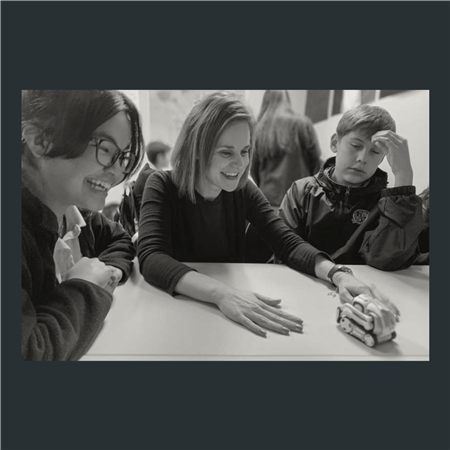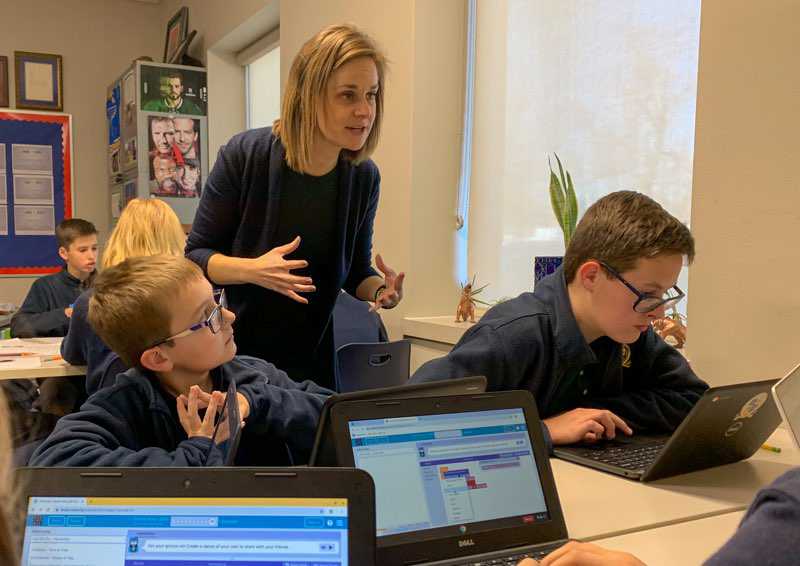
Computer Science found me by way of my daughter.
Full Story
Computer Science found me by way of my daughter. She is currently 10 years old and quickly fell in love with Minecraft. I wanted to support her love of all things computers by asking a myriad of questions to the CS teacher at my school. This quickly led to an important connection with my colleague, and soon my world was opened up to CS when the state of Arkansas created a coding class for 7th/8th graders. That same colleague came to me and said, “I think you would be a perfect fit for this class and these students.” I was panicked as I did not know anything about coding but soon was surrounded by the support of the CS teacher and the CS seniors who agreed to help me out. The first year that I taught 7th grade coding, I would stay about a week ahead of my students in learning Python. This allowed me to connect with what the students that were learning in my class – we could all relate with grappling with the material, getting error messages, and then the success of debugging!
 As a high school government and economics teacher, I quickly started realizing that computer science had a place in my other classes. One day, I was teaching my students how to adjust their income to the rate of inflation. When I used the average teacher salary for my state as an example, I had an eye-opening real moment in front of my students; teachers in my state were making $4,000 less than what they had made 10 years ago. This quickly led to the CS teacher and I designing a project about income-feasibility across the state, combining their social science qualitative research skills with quantitative analysis. A benefit of this pairing is that my students realized that real humans are behind each of those percentages on a graph.
As a high school government and economics teacher, I quickly started realizing that computer science had a place in my other classes. One day, I was teaching my students how to adjust their income to the rate of inflation. When I used the average teacher salary for my state as an example, I had an eye-opening real moment in front of my students; teachers in my state were making $4,000 less than what they had made 10 years ago. This quickly led to the CS teacher and I designing a project about income-feasibility across the state, combining their social science qualitative research skills with quantitative analysis. A benefit of this pairing is that my students realized that real humans are behind each of those percentages on a graph.This became a starting point for my pursuit to leverage computer science as a tool for teaching social science classes. I learned from social science researchers that they were using tools like Python to create their data sets. This surprised me because this was the same programming language that I had taught my 7th graders. I tell my government/economics students that if they are really interested in pursuing research, they should learn CS.
Computer science is a critical tool for social science as we collect, transform, and analyze data. Data impacts how we view ourselves and others view us. For instance, data collected as part of this year’s Census will impact about $657 billion annually given to communities. As an enrolled citizen of the Cherokee Nation, I belong to a community that is often underrepresented when it comes to pie charts and bar graphs. Underrepresentation and the related under-resourcing can lead to erasures of entire communities. As educators, we must create a curriculum that can protect our most vulnerable communities. Equity of and access to information is vital so that our communities can have a voice. This is why we need campaigns like #CherokeeNationCounts. CS and data science are important tools that can give voice to those who are underrepresented or not represented at all.
To make informed decisions, the next generation of leaders will need to understand how to approach and solve problems. Connecting computer science to social science opens an entire new toolbox and allows them to be even better problem solvers. This past October, I met Dr. Abigail Joseph in Chicago as we began our CSTA Equity Fellowship. I was immediately drawn to her because she was talking about the need to get teachers from beyond STEM subject areas interested in integrating CS in their curriculum and I was a social science teacher looking to connect with CS. Dr. Joseph herself had a determined path into the field of CS as she wanted to create seats at the table for all. I want to share in her example so that we can create pathways for teachers and students to know that computer science is more than programming; it is a tool that can move the pendulum forward in ways that benefit our communities as a whole.
Currently, I am working with a former student, Matthew Cunningham, who will obtain his degree in Science, Technology, and Society from Stevens Institute of Technology in 2021. We hope to create an interactive article that brings the connections of CS and SS to K-12 teachers. This will be a great counterpart to Dr. Abigail Joseph’s research and knowledge that we will be presenting at the CSTA Annual Conference.
About the Author
 Rebecca Luebker is an enrolled citizen of the Cherokee Nation is the Social Science Chair at Haas Hall Academy in Fayetteville, Arkansas. Most of Rebecca’s academic duties are in the areas of Government and Economics, where she has been awarded the 2017 Gilder Lehrman Arkansas History Teacher of the Year. Computer Science has recently become a passion for her through her daughter. Her 10-year-old daughter has been interested in all things computer since she was 6, and to understand her interests she wanted to learn more about it. In 2017, in collaboration with the Computer Science Chair at her school, they developed a middle school Coding curriculum. Through this experience, she has been able to enjoy the struggles and successes that computer science brings to the classroom, and the ability to connect computer science and social science in cross-curricular endeavors.
Rebecca Luebker is an enrolled citizen of the Cherokee Nation is the Social Science Chair at Haas Hall Academy in Fayetteville, Arkansas. Most of Rebecca’s academic duties are in the areas of Government and Economics, where she has been awarded the 2017 Gilder Lehrman Arkansas History Teacher of the Year. Computer Science has recently become a passion for her through her daughter. Her 10-year-old daughter has been interested in all things computer since she was 6, and to understand her interests she wanted to learn more about it. In 2017, in collaboration with the Computer Science Chair at her school, they developed a middle school Coding curriculum. Through this experience, she has been able to enjoy the struggles and successes that computer science brings to the classroom, and the ability to connect computer science and social science in cross-curricular endeavors.